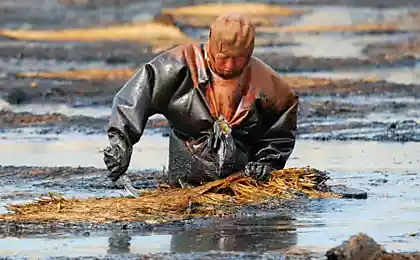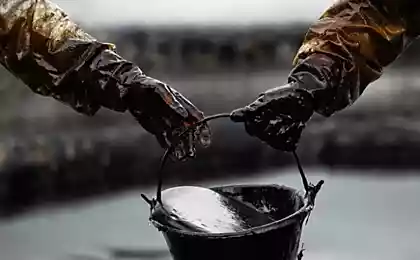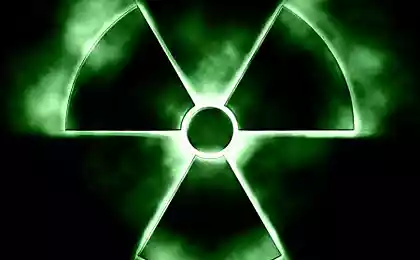464
Animals-extreme
Some of them live in liquid asphalt, the other in boiling water and radiation, and others — in the Dead sea. Of course, most of these animals, only bacteria and microorganisms, but among the extremophiles (so-called organisms that can live and reproduce under extreme environmental conditions), there are also larger creatures.
Eat oil Last year, German scientists discovered in the lake Peach lake, located on the island of Trinidad, in the Caribbean sea, a new species of anaerobic bacteria. And all anything, if Peach lake is the life-giving water was not filled with bitumen. This lake is one of the largest natural reservoirs of bitumen on the planet.
Up to this point, scientists believed that anaerobic bacteria can decompose the oil in conditions where the oil environment is bordered by water. But having studied the composition of the oil, the researchers found that there was a very small, no larger than 1-3 MICS, water drops that are likely to have underground origin. These tiny water filled bubbles methaneproducing complex groups of microbes that break down oil, changing its chemical composition, and thus formed viscous bitumen.
Fifty three million four hundred fifteen thousand six hundred sixty four
Lake Peach lake is a natural reservoir of asphalt / ©Flickr
Radiation as a resort Apparently, it perceives the radiation of gram-positive coccus with a characteristic called Deinococcus radiodurans, because it can survive doses up to 10 thousand (!) Gr. For comparison, the lethal radiation dose for humans is 5 G. Deinococcus radioduransсчитается one of the most resistant to radiation of organisms in the world. How does he do it? The fact that this bacterium is kept in his cell for several copies of the genome, packaged in the form of a torus or ring. These extra copies allow to exactly recover the genome after numerous single - and double-stranded breaks.
Two million seventy five thousand six hundred sixteen
Deinococcus radiodurans / ©Flickr
"Ebullient" life Hyperthermophile referred to as organisms that grow and multiply at temperatures above 60°C. the Optimum temperature for these lovers of "hot" and is equal to 80°C, and some can withstand higher temperatures — more than 100°C. moreover, some of these creatures are able to resist acidity and radiation.
The fact that hyperthermophiles belong to the archaea — the ancient domain of living organisms that are unicellular and do not have, as you know, neither nucleus nor any membrane. The conditions of life on our planet in those early days, when there were widespread archaea were relevant, so these creatures feel in their homes.
But hot water is enjoyed not only the microorganisms. In the depths of the Caribbean sea, near the hydrothermal vents live in a beautiful polychaete worms, which, however, hiding their bodies in long chitinous tubes.
Eight million nine hundred forty eight thousand nine hundred twenty eight
Chitinous tube in which polychaete worms are hiding-extremophiles / ©Flickr
Psychrophile So difficult to say the name of the called living entities, who, by contrast, prefer low temperature. Thus, the nematode Panagrolaimus davidi can survive being completely frozen in ice. Yes there are nematode — some tailed amphibians, such as the Siberian Salamander (were the instances that have been in a daze in the permafrost from 80 to 100 years (!), and then safely returned to life), anurans, some species of turtles and snakes, can freeze the water that is outside the cells in their bodies to keep their cells in conditions of prolonged low temperatures.
But the family nototheniid fish that inhabit the waters of the Arctic and Antarctic, and even swim with the temperature of -1,9°C, which is close to freezing. About bacteria and can not speak: as shown by studies of subglacial lake Vostok in Antarctica, some of the microorganisms are able to survive being frozen in ice for millions of years.
Forty three million nine hundred sixty nine thousand one hundred six
The Antarctic toothfish fish family nototheniid / ©Flickr
Fans salty
They are called halophile — extremophiles that prefer habitat conditions with high salinity — sea, salt lakes, saline soils, etc. of Course, the most extreme are the microbes that live in the depths of the Dead sea. But there are halophilic animals, mostly marine, that are not able to tolerate salinity below 30 ppm. This radiolarian, reef-building corals, the inhabitants of those coral reefs and mangroves, echinoderms, cephalopods, many species of crustaceans, etc.
Seven million five hundred forty three thousand four hundred eighty seven
Mating brine shrimp, is the species of crustaceans belonging to galafilm / © Hans Hillewaert
In space
In the vacuum of space, living organisms are also able to survive. These include, for example, is tihohodka is a very interesting animal, a type of microscopic invertebrate relatives to the arthropods. This is quite nice "bear" is able to withstand incredibly low and extremely high (up to 100°C) temperatures, high radiation levels, incredible pressure (similar to that which exists at the bottom of the Mariana trench), the lack of moisture for more than a hundred years and finally the open space (scientists were sent the animals into orbit).
Seventeen million six hundred seventy five thousand four hundred sixty
Tihohodka / ©Flickr Precisely because of the existence of extremophiles, scientists have hope that we can find life on the frozen moons of Jupiter and Saturn — Europe and Titan. published
P. S. And remember, only by changing their consumption - together we change the world! ©
Source: naked-science.ru/article/top/zhivotnye-ekstremaly
Eat oil Last year, German scientists discovered in the lake Peach lake, located on the island of Trinidad, in the Caribbean sea, a new species of anaerobic bacteria. And all anything, if Peach lake is the life-giving water was not filled with bitumen. This lake is one of the largest natural reservoirs of bitumen on the planet.
Up to this point, scientists believed that anaerobic bacteria can decompose the oil in conditions where the oil environment is bordered by water. But having studied the composition of the oil, the researchers found that there was a very small, no larger than 1-3 MICS, water drops that are likely to have underground origin. These tiny water filled bubbles methaneproducing complex groups of microbes that break down oil, changing its chemical composition, and thus formed viscous bitumen.
Fifty three million four hundred fifteen thousand six hundred sixty four
Lake Peach lake is a natural reservoir of asphalt / ©Flickr
Radiation as a resort Apparently, it perceives the radiation of gram-positive coccus with a characteristic called Deinococcus radiodurans, because it can survive doses up to 10 thousand (!) Gr. For comparison, the lethal radiation dose for humans is 5 G. Deinococcus radioduransсчитается one of the most resistant to radiation of organisms in the world. How does he do it? The fact that this bacterium is kept in his cell for several copies of the genome, packaged in the form of a torus or ring. These extra copies allow to exactly recover the genome after numerous single - and double-stranded breaks.
Two million seventy five thousand six hundred sixteen
Deinococcus radiodurans / ©Flickr
"Ebullient" life Hyperthermophile referred to as organisms that grow and multiply at temperatures above 60°C. the Optimum temperature for these lovers of "hot" and is equal to 80°C, and some can withstand higher temperatures — more than 100°C. moreover, some of these creatures are able to resist acidity and radiation.
The fact that hyperthermophiles belong to the archaea — the ancient domain of living organisms that are unicellular and do not have, as you know, neither nucleus nor any membrane. The conditions of life on our planet in those early days, when there were widespread archaea were relevant, so these creatures feel in their homes.
But hot water is enjoyed not only the microorganisms. In the depths of the Caribbean sea, near the hydrothermal vents live in a beautiful polychaete worms, which, however, hiding their bodies in long chitinous tubes.
Eight million nine hundred forty eight thousand nine hundred twenty eight
Chitinous tube in which polychaete worms are hiding-extremophiles / ©Flickr
Psychrophile So difficult to say the name of the called living entities, who, by contrast, prefer low temperature. Thus, the nematode Panagrolaimus davidi can survive being completely frozen in ice. Yes there are nematode — some tailed amphibians, such as the Siberian Salamander (were the instances that have been in a daze in the permafrost from 80 to 100 years (!), and then safely returned to life), anurans, some species of turtles and snakes, can freeze the water that is outside the cells in their bodies to keep their cells in conditions of prolonged low temperatures.
But the family nototheniid fish that inhabit the waters of the Arctic and Antarctic, and even swim with the temperature of -1,9°C, which is close to freezing. About bacteria and can not speak: as shown by studies of subglacial lake Vostok in Antarctica, some of the microorganisms are able to survive being frozen in ice for millions of years.
Forty three million nine hundred sixty nine thousand one hundred six
The Antarctic toothfish fish family nototheniid / ©Flickr
Fans salty
They are called halophile — extremophiles that prefer habitat conditions with high salinity — sea, salt lakes, saline soils, etc. of Course, the most extreme are the microbes that live in the depths of the Dead sea. But there are halophilic animals, mostly marine, that are not able to tolerate salinity below 30 ppm. This radiolarian, reef-building corals, the inhabitants of those coral reefs and mangroves, echinoderms, cephalopods, many species of crustaceans, etc.
Seven million five hundred forty three thousand four hundred eighty seven
Mating brine shrimp, is the species of crustaceans belonging to galafilm / © Hans Hillewaert
In space
In the vacuum of space, living organisms are also able to survive. These include, for example, is tihohodka is a very interesting animal, a type of microscopic invertebrate relatives to the arthropods. This is quite nice "bear" is able to withstand incredibly low and extremely high (up to 100°C) temperatures, high radiation levels, incredible pressure (similar to that which exists at the bottom of the Mariana trench), the lack of moisture for more than a hundred years and finally the open space (scientists were sent the animals into orbit).
Seventeen million six hundred seventy five thousand four hundred sixty
Tihohodka / ©Flickr Precisely because of the existence of extremophiles, scientists have hope that we can find life on the frozen moons of Jupiter and Saturn — Europe and Titan. published
P. S. And remember, only by changing their consumption - together we change the world! ©
Source: naked-science.ru/article/top/zhivotnye-ekstremaly























